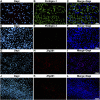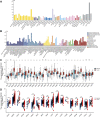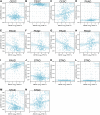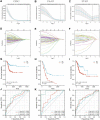Multi-functional gene ZNF281 identified as a molecular biomarker in soft tissue regeneration and pan-cancer progression
- PMID: 36685971
- PMCID: PMC9849369
- DOI: 10.3389/fgene.2022.1082654
Multi-functional gene ZNF281 identified as a molecular biomarker in soft tissue regeneration and pan-cancer progression
Abstract
Regeneration and tumorigenesis are indicated as related processes, while regeneration leads to life and the outcome of tumorigenesis is death. Here, we show the upregulation of zfp281 (zinc finger 281) in our adipose de novo regeneration model through RNA-seq analysis. Then, we validated the upregulation of zfp281 in adipose regeneration via immunofluorescence. Following that, we found that ZNF281 (the human homolog of Zfp281) was upregulated in most types of cancer and related to worse prognosis in 10 tumors. We further investigated the role of ZNF281 in cervical squamous cell carcinoma and endocervical adenocarcinoma (CESC), pancreatic adenocarcinoma (PAAD), and stomach adenocarcinoma (STAD) and confirmed the high accuracy in the clinical diagnostic feature. Beyond that, based on these three types of cancers, we analyzed the ZNF281-related tumor immune infiltration and DNA methylation sites and finally built risk prediction models for future disease diagnosis. Taken together, our findings provide new insights into the dual role of ZNF281, and we found that it was a potential biomarker for regeneration and tumor prognosis.
Keywords: ZNF281; biomarker; pan-cancer; regeneration; tumorigenesis.
Copyright © 2023 Hou, Luan and Fu.
Conflict of interest statement
The authors declare that the research was conducted in the absence of any commercial or financial relationships that could be construed as a potential conflict of interest.
Figures






Similar articles
-
ZNF281/Zfp281 is a target of miR-1 and counteracts muscle differentiation.Mol Oncol. 2020 Feb;14(2):294-308. doi: 10.1002/1878-0261.12605. Epub 2019 Dec 24. Mol Oncol. 2020. PMID: 31782884 Free PMC article.
-
Identification of SHCBP1 as a potential biomarker involving diagnosis, prognosis, and tumor immune microenvironment across multiple cancers.Comput Struct Biotechnol J. 2022 Jun 18;20:3106-3119. doi: 10.1016/j.csbj.2022.06.039. eCollection 2022. Comput Struct Biotechnol J. 2022. PMID: 35782736 Free PMC article.
-
Pan-cancer analysis identifies NT5E as a novel prognostic biomarker on cancer-associated fibroblasts associated with unique tumor microenvironment.Front Pharmacol. 2022 Dec 7;13:1064032. doi: 10.3389/fphar.2022.1064032. eCollection 2022. Front Pharmacol. 2022. PMID: 36569293 Free PMC article.
-
ZNF281/ZBP-99: a new player in epithelial-mesenchymal transition, stemness, and cancer.J Mol Med (Berl). 2014 Jun;92(6):571-81. doi: 10.1007/s00109-014-1160-3. Epub 2014 May 18. J Mol Med (Berl). 2014. PMID: 24838609 Review.
-
The cancer driver genes IDH1/2, JARID1C/ KDM5C, and UTX/ KDM6A: crosstalk between histone demethylation and hypoxic reprogramming in cancer metabolism.Exp Mol Med. 2019 Jun 20;51(6):1-17. doi: 10.1038/s12276-019-0230-6. Exp Mol Med. 2019. PMID: 31221981 Free PMC article. Review.
Cited by
-
Zinc finger proteins: guardians of genome stability.Front Cell Dev Biol. 2024 Jul 25;12:1448789. doi: 10.3389/fcell.2024.1448789. eCollection 2024. Front Cell Dev Biol. 2024. PMID: 39119040 Free PMC article. Review.
-
Identification and validation of the role of ZNF281 in 5-fluorouracil chemotherapy of gastric cancer.J Cancer Res Clin Oncol. 2024 Jun 16;150(6):307. doi: 10.1007/s00432-024-05838-8. J Cancer Res Clin Oncol. 2024. PMID: 38880820 Free PMC article.
-
Tumour initiated purinergic signalling promotes cardiomyocyte RBFOX1 degradation and cardiotoxicity from DNA damaging anticancer agents.Nat Commun. 2025 Jul 25;16(1):6861. doi: 10.1038/s41467-025-62172-4. Nat Commun. 2025. PMID: 40715150 Free PMC article.
References
LinkOut - more resources
Full Text Sources

